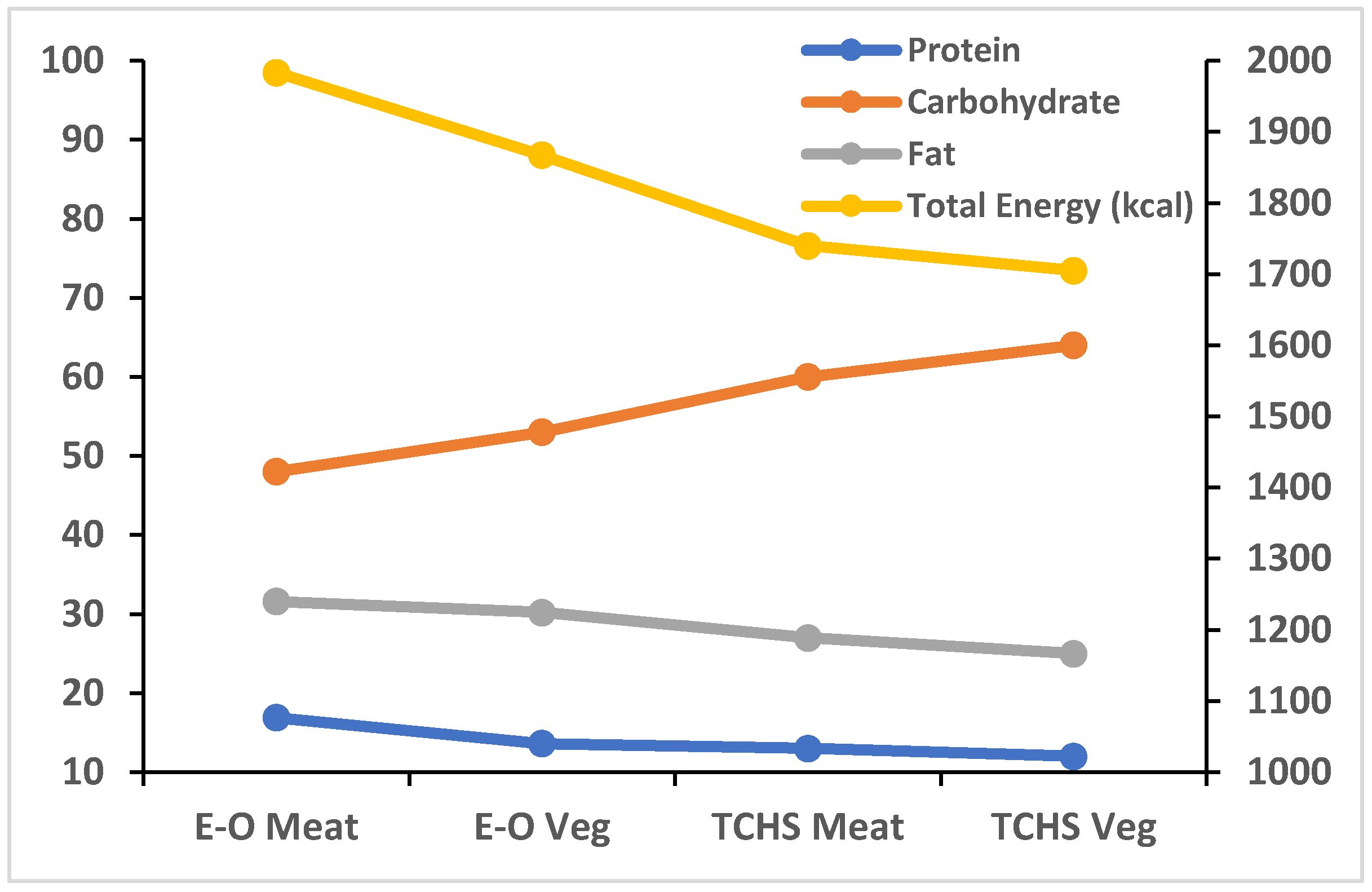Vegetarian Diets, Ayurveda, and the Case for an Integrative Nutrition Science
Abstract
:1. Introduction
2. Comparison of Cohort Diets
3. The Ayurvedic Perspective
4. Vegetarianism and Ayurveda
5. Conclusions
Author Contributions
Funding
Institutional Review Board Statement
Informed Consent Statement
Data Availability Statement
Acknowledgments
Conflicts of Interest
References
- Segovia-Siapco, G.; Sabate, J. Health and sustainability outcomes of vegetarian dietary patterns: A revisit of the EPIC-Oxford and the Adventist Health Study-2 cohorts. Eur. J. Clin. Nutr. 2019, 72, 60–70. [Google Scholar] [CrossRef] [PubMed]
- Lawrence, M.A.; McNaughton, S.A. Vegetarian diets and health. BMJ 2019, 366, l5272. [Google Scholar] [CrossRef] [PubMed]
- Kahleova, H.; Levin, S.; Barnard, N.D. Vegetarian Dietary Patterns and Cardiovascular Disease. Prog. Cardiovasc. Dis. 2018, 61, 54–61. [Google Scholar] [CrossRef]
- Dinu, M.; Abbate, R.; Gensini, G.F.; Casini, A.; Sofi, F. Vegetarian, vegan diets and multiple health outcomes: A systematic review with meta-analysis of observational studies. Crit. Rev. Food Sci. Nutr. 2017, 57, 3640–3649. [Google Scholar] [CrossRef] [PubMed]
- Tong, T.Y.N.; Appleby, P.N.; Bradbury, K.E.; Perez-Cornago, A.; Travis, R.C.; Clarke, R.; Key, T.J. Risks of ischaemic heart disease and stroke in meat eaters, fish eaters, and vegetarians over 18 years of follow-up: Results from the prospective EPIC-Oxford study. BMJ 2019, 366, l4897. [Google Scholar] [CrossRef] [PubMed] [Green Version]
- Chiu, T.H.T.; Chang, H.R.; Wang, L.Y.; Chang, C.C.; Lin, M.N.; Lin, C.L. Vegetarian diet and incidence of total, ischemic, and hemorrhagic stroke in 2 cohorts in Taiwan. Neurology 2020, 94, e1112–e1121. [Google Scholar] [CrossRef] [PubMed] [Green Version]
- Harini, J.A.; Luthra, A.; Madeka, S.; Shankar, P.; Mandava, P.; Pervaje, R.; Aaron, S.; Purushotham, A. Ayurvedic Treatment of Acute Ischemic Stroke: A Prospective Observational Study. Glob. Adv. Health Med. 2019, 8. [Google Scholar] [CrossRef] [Green Version]
- Pandian, J.D.; Toor, G.; Arora, R.; Kaur, P.; Dheeraj, K.V.; Bhullar, R.S.; Sylaja, P.N. Complementary and alternative medicine treatments among stroke patients in India. Top. Stroke Rehabil. 2012, 19, 384–394. [Google Scholar] [CrossRef] [PubMed]
- Banerjee, S.; Debnath, P.; Debnath, P.K. Ayurnutrigenomics: Ayurveda-inspired personalized nutrition from inception to evidence. J. Tradit. Complementary Med. 2015, 5, 228–233. [Google Scholar] [CrossRef] [PubMed] [Green Version]
- Hankey, A. Establishing the Scientific Validity of Tridosha part 1: Doshas, Subdoshas and Dosha Prakritis. Anc. Sci. Life 2010, 29, 6–18. [Google Scholar] [PubMed]
- Acharya, J.T. Sushruta Samhita with Nibandha Sangraha Commentary of Dalhanacharya; Chaukhamba Orientalia: Varanasi, India, 2007. [Google Scholar]
- Sharma, S. Ashtanga Samgraha of Vriddha Vagbhata, Sasilekha Sanskrit Commentary by Indu; Chaukhamba Orientalia: Varanasi, India, 2008; p. 568. [Google Scholar]
- Mahalle, N.P.; Kulkarni, M.V.; Pendse, N.M.; Naik, S.S. Association of constitutional type of Ayurveda with cardiovascular risk factors, inflammatory markers and insulin resistance. J. Ayurveda Integr. Med. 2012, 3, 150–157. [Google Scholar] [CrossRef] [PubMed] [Green Version]
- Papier, K.; Appleby, P.N.; Fensom, G.K.; Knuppel, A.; Perez-Cornago, A.; Schmidt, J.A.; Tong, T.Y.N.; Key, T.J. Vegetarian diets and risk of hospitalisation or death with diabetes in British adults: Results from the EPIC-Oxford study. Nutr. Diabetes 2019, 9, 7. [Google Scholar] [CrossRef] [PubMed]
- Bredesen, D.E.; Rao, R.V. Ayurvedic Profiling of Alzheimer′s Disease. Altern. Ther. Health Med. 2017, 23, 46–50. [Google Scholar] [PubMed]
- Kumar, N.; Mishra, S. Critical review of Vatavyadhi in Brihattrayi. Intl. J. Appl. Res. 2020, 6, 60–62. [Google Scholar]
- Acharya, J.T. Charaka Samhita with Ayurveda Dipika Commentary of Chakrapanidatta; Chaukhamba Orientalia: Varanasi, India, 2007; p. 619, Chikitsasthana Chapter 28, verse 53. [Google Scholar]
- Murthy, K.R.S. Madhava Nidana of Madhavakara with English translation, Critical Introduction and Appendices; Chaukhamba Orientalia: Varanasi, India, 2009; p. 84, Chapter 22, verses 39–41. [Google Scholar]
- Acharya, J.T. Charaka Samhita with Ayurveda Dipika Commentary of Chakrapanidatta; Chaukhamba Orientalia: Varanasi, India, 2007; Chikitsasthana Chapter 28, verses 61, 221–229. [Google Scholar]
- Anoop, A.S.; Anupama, A.S.; Sagar, K. Ayurvedic understanding and management of cerebrovascular accident (stroke with ischemia and hemorrhage): A case study. Int. J. Sci. Res. 2020, 9, 75–77. [Google Scholar]
- Kșemaśarma. Kșemakutūhalam; Foundation for Revitalization of Local Health Traditions: Bangalore, India, 2009. [Google Scholar]
- Ashtanga Hridaya of Vagbhatta. Ashtanga Hridaya of Vagbhatta; Chaukhamba Orientalia: Varanasi, India, 2007; Sutrasthana 3; p. 37. [Google Scholar]
- Ashtanga Hridaya of Vagbhatta. Ashtanga Hridaya of Vagbhatta; Chaukhamba Orientalia: Varanasi, India, 2007; Sutrasthana 3, verse 58. [Google Scholar]
- Agnivesha. Charaka Samhita; Ayurveda Dipika by Chakrapanidatta, Chaukhamba Orientalia: Varanasi, India, 2007; Sutrasthana 7, verses 36–37. [Google Scholar]
- Hankey, A. Ayurveda and the battle against chronic disease: An opportunity for Ayurveda to go mainstream? J. Ayurveda Integr. Med. 2010, 1, 9–12. [Google Scholar] [CrossRef] [PubMed] [Green Version]
- Furst, D.E.; Venkatraman, M.M.; McGann, M.; Manohar, P.R.; Booth-LaForce, C.; Sarin, R.; Sekar, P.G.; Raveendran, K.G.; Mahapatra, A.; Gopinath, J.; et al. Double-blind, randomized, controlled, pilot study comparing classic ayurvedic medicine, methotrexate, and their combination in rheumatoid arthritis. J. Clin. Rheumatol. 2011, 17, 185–192. [Google Scholar] [CrossRef] [PubMed] [Green Version]

Publisher’s Note: MDPI stays neutral with regard to jurisdictional claims in published maps and institutional affiliations. |
© 2021 by the authors. Licensee MDPI, Basel, Switzerland. This article is an open access article distributed under the terms and conditions of the Creative Commons Attribution (CC BY) license (https://creativecommons.org/licenses/by/4.0/).
Share and Cite
Purushotham, A.; Hankey, A. Vegetarian Diets, Ayurveda, and the Case for an Integrative Nutrition Science. Medicina 2021, 57, 858. https://doi.org/10.3390/medicina57090858
Purushotham A, Hankey A. Vegetarian Diets, Ayurveda, and the Case for an Integrative Nutrition Science. Medicina. 2021; 57(9):858. https://doi.org/10.3390/medicina57090858
Chicago/Turabian StylePurushotham, Archana, and Alex Hankey. 2021. "Vegetarian Diets, Ayurveda, and the Case for an Integrative Nutrition Science" Medicina 57, no. 9: 858. https://doi.org/10.3390/medicina57090858
APA StylePurushotham, A., & Hankey, A. (2021). Vegetarian Diets, Ayurveda, and the Case for an Integrative Nutrition Science. Medicina, 57(9), 858. https://doi.org/10.3390/medicina57090858




